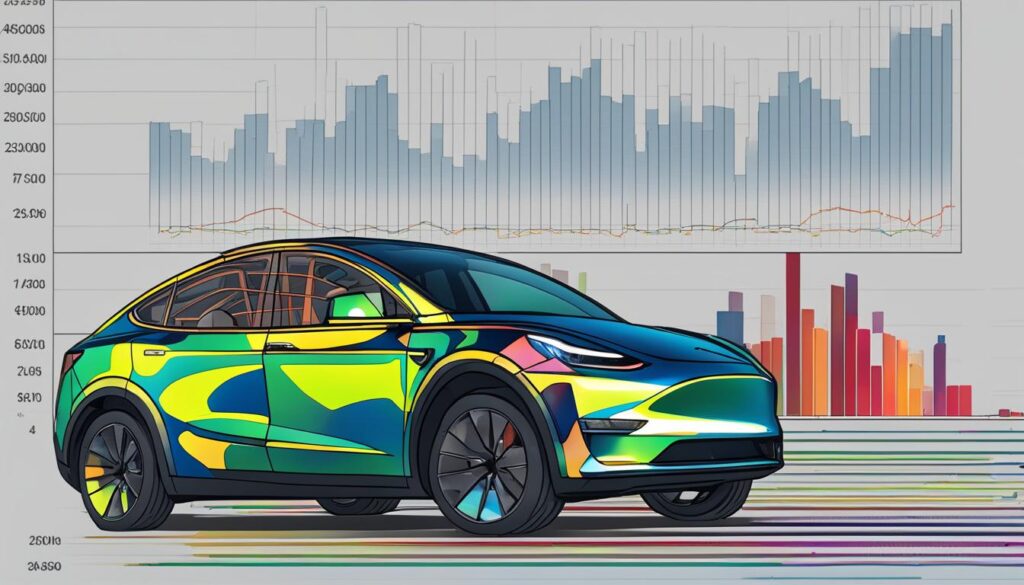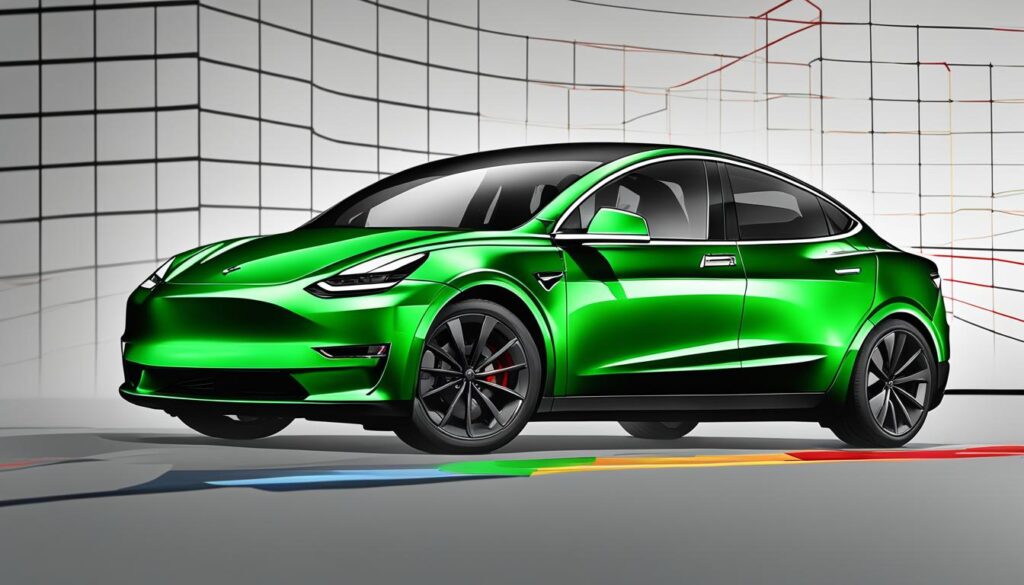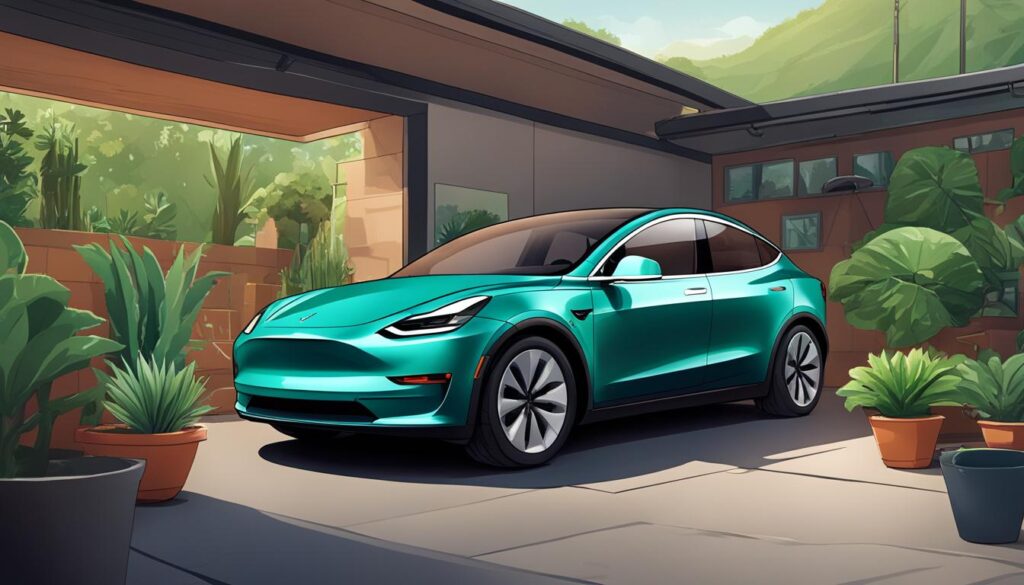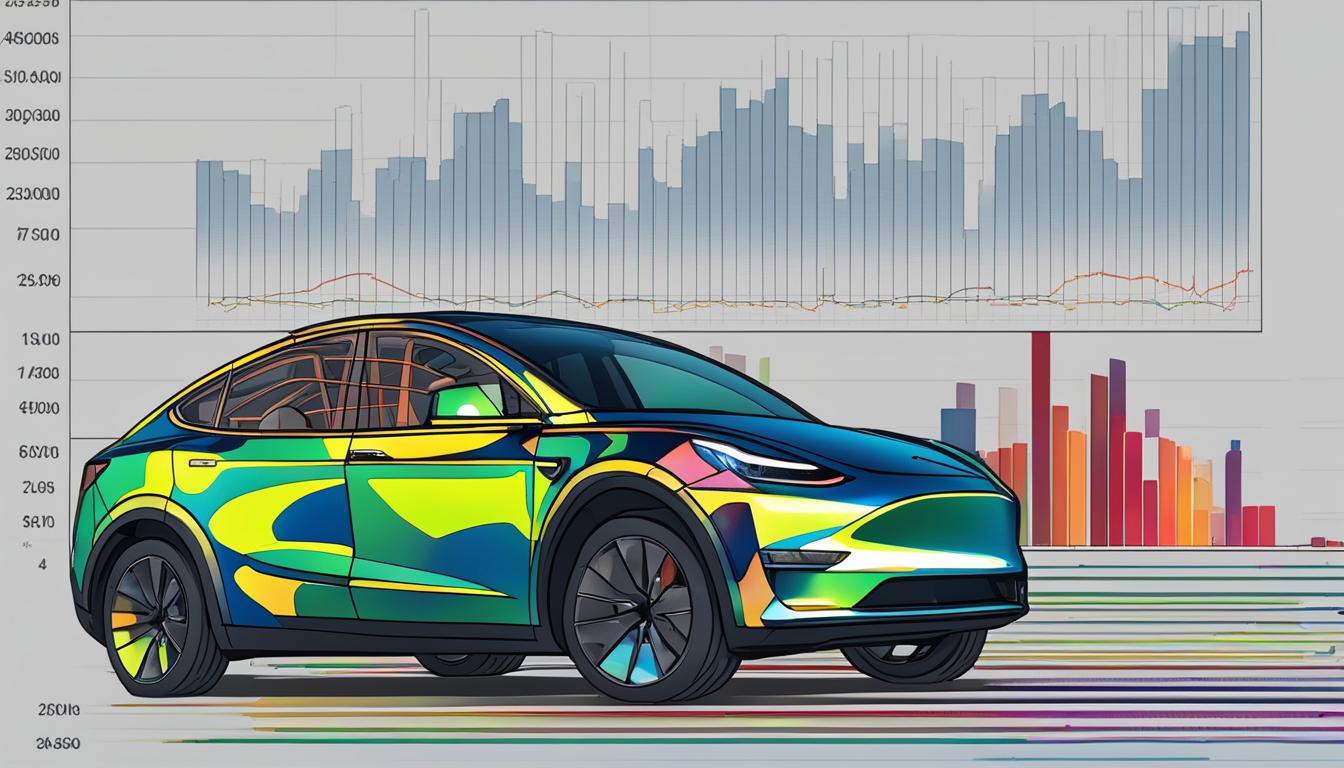When it comes to purchasing a Tesla Model Y, investors and automotive enthusiasts alike often ponder the vehicle’s depreciation, resale value, and viability as a long-term investment. It’s well-known that cars devalue over time, but the Tesla Model Y depreciation story unfolds rather uniquely.
With the escapade starting at a new purchase price of around $59,232, this sophisticated electric vehicle (EV) presents a depreciation of 39% after five years, shaping its foreseeable resale value at approximately $36,363.
Buyers of the Model Y might breathe a little easier knowing that after the first year, the depreciation hit isn’t as steep as some might expect, with only $2,920 shaved off its initial value. Fast forward to the fifth year, and its enduring appeal in the EV market sustains its significance as a long-term investment. What makes the Tesla Model Y a distinctive case? It’s worth diving into the details.
Key Takeaways
- Expect a 39% depreciation on a Tesla Model Y over a five-year span.
- After one year, the Model Y’s depreciation is estimated at $2,920, indicating a slower initial value decline.
- Annual depreciation figures reveal the biggest dip occurs during the early years of ownership.
- The projected resale value stands strong, retaining a significant portion of its original purchase price.
- Model Y’s high demand and breakthrough technology position it as a valuable long-term investment.
Understanding Vehicle Depreciation Basics
If you’ve contemplated the purchase or sale of a Tesla Model Y, understanding vehicle depreciation is crucial. It’s the silent factor that steadily erodes the value of a vehicle over time. As a prospective owner or current investor, recognizing the factors affecting Tesla Model Y depreciation could enhance your financial savviness and planning.

Vehicles are not immune to the passage of time or the volatility of the market, both of which play pivotal roles in shaping car resale value. The dimishing return on your automotive asset is not a random occurrence; it’s predictable when armed with the right knowledge.
What is Depreciation and Why Does it Matter?
Simply put, depreciation is the rate at which a car loses its value over time. For any car enthusiast or prudent investor, depreciation is more than a buzzword; it’s a financial indicator determining the potential return on investment. When considering the Tesla Model Y, which departs the dealership with significant fanfare and a price tag to match, the trajectories of its value decline can mark the difference between a wise purchase and a costly oversight.
How Does Car Depreciation Work?
The nuts and bolts of vehicle depreciation involve a mix of elemental market forces and consumer behaviors. New cars, such as the Tesla Model Y, typically experience the sharpest depreciation hit in the initial years following purchase. Over time, this rate slows down, but the aggregate effect can be eye-opening when you calculate the total car resale value change over your ownership period.
| Year | Depreciation Rate | Residual Value (%) | Estimated Resale Value ($) |
|---|---|---|---|
| 1 | Small | 95.07 | 56,312 |
| 3 | Moderate | 77.13 | 45,686 |
| 5 | Significant | 61.39 | 36,363 |
As depicted, the Tesla Model Y showcases a decline closely aligned with its mileage, care, and the ceaseless march of new models rolling off the assembly lines. For savvy shoppers and sellers, keeping a keen eye on these patterns could yield benefits when negotiating the vehicle’s worth in the market.
The Tesla Advantage: Holding Value Over Time
As the electric vehicle (EV) landscape evolves, Tesla Model Y owners enjoy a significant benefit that stands out in the automotive market—their cars’ remarkable ability to preserve value. This striking attribute is the culmination of unyielding market demand and constant waves of technological innovation that have become synonymous with the Tesla brand. This phenomenon is not merely an abstract concept but is reflected concretely in the vehicle’s value depreciation, which is notably less severe when compared to other vehicles in its class.
Tesla’s Market Demand and Its Impact
One of the key drivers behind the Tesla Model Y’s staunch valuation is the unwavering demand for this model. Buyers are often willing to wait months to get behind the wheel of their very own Tesla, indicative of the brand’s strong cachet and the allure of owning a cutting-edge EV. This demand doesn’t wane even in the secondary market, as used Tesla Model Y vehicles command high interest, prompting a strong resale value that is music to the ears of current owners.
Technological Innovation and Resale Prices
Tesla’s strategic emphasis on constantly upgrading and enhancing their vehicles with state-of-the-art technologies, such as the Full Self Driving (FSD) feature, plays a pivotal role in shaping the Model Y’s depreciation curve. Such advancements not only enhance the driving experience but also add significant value, distinguishing these vehicles from their counterparts which lack similar tech. The Tesla Model Y stands out as a showcase of technological innovation that has tangible benefits, translating into superior resale prices and a favorable position in a competitive EV market.

Conclusively, the Tesla Model Y heralds a shift in the traditional understanding of vehicle depreciation. Its owners indulge in the advantages of a vehicle that is not only thrilling to drive but also promises a fiscal prudence seldom seen in automotive acquisitions. This combination of desirability and innovation casts a bright forecast for the Tesla Model Y, securing its status as one of the wisest automotive investments in today’s market.
Analyzing Tesla Model Y’s Depreciation Rate
When considering the financial implications of owning a Tesla Model Y, it’s essential to evaluate its depreciation rate to understand the vehicle’s value over time. Not all vehicles depreciate equally, and the Model Y’s pattern has shown to be substantially different from its competitors, making it an intriguing subject for prospective buyers and current owners alike.
Annual Depreciation Trends for the Tesla Model Y
Depreciation is often the largest expense incurred by vehicle owners, and analyzing annual depreciation trends provides valuable insight into the long-term financial aspects of vehicle ownership. In stark contrast to its counterparts, the Tesla Model Y maintains a commendable retention of value, diminishing at a much slower pace than other models in the electric vehicle spectrum.

The initial depreciation loss for a Tesla Model Y is relatively minor, considering the norm for new vehicle purchases. Owners can expect to confront a minor dip of roughly 5% after the first year. Yet, the Model Y showcases extraordinary resilience in the following years, upholding a substantial proportion of its original value. A tangible reflection of its endurance in the marketplace are the 2021 models, retaining a notable 96.59% of their original purchase price.
Comparing Model Y Depreciation to Other Vehicles
Car value comparison with other electric vehicles reveals that the Tesla Model Y stands out with its exceptional ability to maintain value. While vehicles like the BMW i3 and Nissan Leaf witness precipitous falls in value, with up to a 60% decrease over three years, the Model Y presents a much more contained annual depreciation trend, thereby ensuring a higher resale value. This reinforces the Model Y’s reputation as a vehicle that defies the traditional rapid devaluation that plagues most new car purchases.
Below is a comparative chart highlighting how the depreciation rate of a Tesla Model Y stacks up against its rivals and underscores the impressive retention of value that Tesla owners can enjoy:
| Vehicle | Year | Depreciation | Residual Value |
|---|---|---|---|
| Tesla Model Y | After 1 Year | 5% | 95% |
| Tesla Model Y | After 3 Years | Less than 10% | More than 90% |
| Comparative EVs | After 3 Years | Up to 60% | 40% |
The degree to which the Tesla Model Y preserves its worth not only serves as a benchmark for electric vehicles but also adds a considerable advantage for those looking to secure their investment in the ballooning EV market. Whether you’re in the market for a new Tesla Model Y or weighing the prospect of entering the resale market, these annual depreciation trends and car value comparisons provide a reliable gauge of what owners may anticipate in terms of vehicular asset performance.
What Factors Affect Tesla Model Y Depreciation
Many potential Tesla Model Y owners are curious about what elements influence the car’s value over time. While general automotive depreciation is a given, certain factors specifically impact the Tesla Model Y depreciation. Let’s delve into how things like mileage, vehicle condition, and the incorporation of advanced technological features play a crucial role in determining the resale value of this popular electric vehicle.
Mileage and Vehicle Condition
Consistent with auto industry standards, the mileage on a Tesla Model Y is a significant indicator of its wear and tear, and ultimately its depreciation. With each mile on the odometer, the potential resale value can take a hit. On the flip side, the condition of a vehicle is just as telling. A Model Y that exhibits minimal wear and tear and has been subjected to meticulous vehicle maintenance can captivate the market despite higher mileage, holding onto more of its value.
Vehicles that bear the evidence of diligent care—free from significant dents, scratches, and interior damage—tend to depreciate at a slower pace. This attentiveness to maintenance preserves not only the operational integrity of the vehicle but also its cosmetic appeal, two factors quintessential to leveraging resale value.
Impact of Technological Features on Value
Where Tesla truly distinguishes itself is through the technological advancements that define its fleet. For a Tesla Model Y, possessing high-end features like Enhanced Autopilot (EAP) and Full Self Driving (FSD) not only enhances the driving experience but also significantly boosts resale value. In the bustling used EV market, these technological impacts on car value are highly material. A Tesla equipped with EAP can see added value of roughly $1,000, while integration of FSD capabilities can appreciate the car’s worth even further.
It becomes clear that advancements in technology are not just about the novel driving experience—they are about investing in a vehicle’s future. Today’s buyers are willing to pay a premium for tomorrow’s tech, affirming that innovations like FSD have a measurable and favorable impact on a Tesla Model Y’s residual value.

| Feature | Value Impact | Additional Resale Value |
|---|---|---|
| Basic Autopilot | Standard | + $0 (Included in base price) |
| Enhanced Autopilot (EAP) | High | + $1,000 |
| Full Self Driving (FSD) | Very High | + $1,500 to $2,000 |
The fusion of technology, condition, and mileage renders a comprehensive overview of the factors impacting the Tesla Model Y depreciation. Owners who navigate these aspects with a keen eye on their impact on resale value will ultimately be best positioned to capitalize on their electric vehicle investment.
Projected Resale Value of the Tesla Model Y
Delving into the future financial landscape of electric vehicles (EVs), the Tesla Model Y stands out for its promising residual value, with a steadfast position in the long-term EV market. By examining the five-year depreciation forecast, a clearer picture emerges of what Tesla Model Y owners can anticipate in terms of investment return.

Our examination of Tesla Model Y long-term value points to a vehicle that is shielded against swift decline, maintaining robust market desirability. The dichotomy of depreciation between Tesla’s Model Y and other vehicles illustrates the striking financial advantage inherent in EVs, especially in a brand that symbolizes innovation and quality.
Five-Year Depreciation Forecast
Armed with data, we can predict that owning a Tesla Model Y could be synonymous with financial acumen. After a period of five years, the cumulative depreciation is expected to hover around 39%, suggesting that the long-term value of the Model Y transcends common ownership fears associated with robust depreciation.
Long-Term Ownership and Depreciation Implications
The horizon of long-term ownership casts an optimistic glow over the Tesla Model Y’s potential for sustained value. Contrary to the rapid decrease in worth seen in many automotive investments, the Model Y’s residual value could remain significantly above that of its contemporaries, a testament to its high quality and consumer demand. A well-tended Model Y, even with miles accumulated, is poised to retain a greater slice of its purchase price—which translates to a wiser financial venture for EV connoisseurs.
| Ownership Year | Depreciation Percentage | Estimated Resale Value |
|---|---|---|
| 1 | 5% | $56,312 |
| 3 | Approx. 23% | $45,686 |
| 5 | 39% | $36,363 |
How to Minimize Depreciation for Your Tesla Model Y
For Tesla Model Y owners, minimizing depreciation is akin to safeguarding a financial investment. Effective vehicle care is critical for maintaining the Tesla Model Y value and ensuring it commands a competitive price in the saturated EV market. The following strategies are not merely suggestions but foundational steps any prudent Tesla owner should consider integrating into their routine to diminish the rate of depreciation and potentially augment the car’s resale value.

Chief among these strategies is keeping the mileage in check. Mindful driving and purposeful usage are instrumental in ensuring that your mileage remains within the average annual limits, as higher mileage can lead to a steeper dip in the car’s worth. But reducing mileage isn’t the sole tactic; consistent attention towards vehicle maintenance plays an equally vital role in the equation.
- Maintenance logs serve as an assurance to prospective buyers, demonstrating a history of care.
- Regularly scheduled servicing and timely replacements of wear-and-tear components extend the lifespan and efficiency of the vehicle.
- Proactively addressing any minor issues before they escalate is key to preventing larger devaluation.
Opting for upgrades, especially those in the technological domain such as Tesla’s FSD (Full Self-Driving) capability can significantly enhance your vehicle’s appeal and resale value. Buyers are often willing to pay a premium for advanced features that promise an enriched driving experience and future-proof technology.
The exterior and interior condition of the Model Y is another cornerstone in maintaining Tesla Model Y value. Steps such as:
- Implementing protective measures like Paint Protection Films (PPF) to shield the paint from scratches and environmental damage.
- Ensuring the interior remains pristine by avoiding stains, rips, and odors that might detract from the car’s appeal.
- Using vehicle-specific cleaning agents that are kind to the Tesla’s unique materials and surfaces.
By embracing these protective and proactive approaches, Tesla owners can not only preserve but sometimes even elevate the resale value of their Tesla Model Y. It’s not simply a matter of ownership; it’s about stewardship of a technologically advanced asset that commands attention in the automotive marketplace.
The Role of Full Self-Driving (FSD) in Resale Value
In the realm of electric vehicles, the Tesla Model Y has consistently stood out for its pioneering technology and strong market performance. Among its suite of advanced features, the Tesla Full Self-Driving (FSD) capability is more than just a pioneering innovation; it’s a pivotal factor that significantly influences the car’s resale value. As we uncover the role of FSD in maintaining the financial integrity of the Tesla Model Y investment, it’s clear why this feature has become a game changer in the electric vehicle industry.
How FSD Capability Can Keep Tesla Model Y’s Value Strong
The Tesla FSD capability is not just a testament to the Model Y’s technological prowess; it also represents an impactful asset in safeguarding the vehicle’s resale price. With the integration of FSD, the Tesla Model Y transitions from being an advanced vehicle to a future-facing investment, potentially doubling its resale value when compared to models lacking this advanced feature. This boost in valuation acknowledges the consumers’ growing inclination towards autonomous driving features, recognizing their transformative impact on daily commutes and long-haul journeys alike.

When the time comes for Tesla Model Y owners to assess the market for a sale, the FSD capability stands as a potent bargaining chip. Advocates of advanced automotive technology are often prepared to pay a premium for a vehicle that not only promises an enhanced driving experience but also stays ahead of the curve in tech adoption. This future-proofing attribute ensures that the Tesla Model Y’s valuation remains competitive in a fast-evolving automotive landscape.
| Feature | Added Value | Increment in Resale Price |
|---|---|---|
| Without FSD | Standard | Baseline Resale Value |
| With FSD | Significant | Up to Double the Standard Resale Value |
Given the tangible benefits accrued from the Tesla Model Y advanced features, it is evident that FSD capability has a pronounced impact on the vehicle’s residual value. As Tesla continues to lead the charge in vehicular autonomy, the Model Y, empowered by FSD, becomes synonymous with a secure and potentially lucrative resale market. Whether it’s for an upgrade within the Tesla lineup or for navigating new avenues, the owner of an FSD-equipped Tesla Model Y can engage in the resale process with heightened confidence.
Tesla Model Y Insurance Costs and Its Effect on Ownership
Expenses associated with vehicle ownership extend beyond the sticker price, and insurance premiums are a significant part of the equation for Tesla Model Y owners. When calculating the total ownership cost of this electric SUV, estimating and mitigating insurance expenses are crucial conversations that impact the overall value proposition of owning a Tesla Model Y. The pursuit of cost-efficient insurance options is hence not just recommended but essential for those looking to streamline their ownership costs.
With an average annual insurance cost hovering around $3,461, Tesla Model Y insurance premiums are a noteworthy factor in the long-term financial planning of ownership. This recurring cost adds a substantial amount to the vehicle’s life cycle expenses, highlighting the need for potential and current owners to actively seek out competitive insurance rates.
Insurance Premiums Over Time
When spread out over the typical ownership period of five years, the Tesla Model Y insurance costs accumulate, representing a substantial sum that demands attention. With premiums potentially reaching upwards of $17,305 cumulatively, it’s apparent that choices surrounding insurance will sway the total ownership cost significantly. It’s an expense that not only affects the current owner but also has the potential to influence the desirability of the vehicle in the resale market.
| Year | Insurance Cost | Total Cost Over Ownership |
|---|---|---|
| 1 | $3,461 | $3,461 |
| 2 | $3,461 | $6,922 |
| 3 | $3,461 | $10,383 |
| 4 | $3,461 | $13,844 |
| 5 | $3,461 | $17,305 |
Advisably, leveraging tools and services that compare insurance quotes can unearth opportunities to minimize these costs. They grant the autonomy to Tesla Model Y users to find premiums that do not unjustly augment the total cost of ownership, thereby preserving the economic viability of their investment.
Maintenance and Its Impact on Tesla Model Y’s Depreciation
For electric vehicle enthusiasts and savvy consumers alike, the allure of a Tesla Model Y extends beyond its sleek design and sustainable prowess; it carries the promise of a wise financial decision. One significant factor contributing to the preserving vehicle value scenario is the Tesla Model Y maintenance costs. These aren’t mere outlays but investments that fortify the vehicle’s lifespan and functionality, effectively moderating the cost of ownership through minimized depreciation.
Maintenance, when adhered to with the same precision as the technology that powers these vehicles, stands at the forefront of efforts to preserve vehicle value. Tesla’s maintenance schedule, meticulously designed for the Model Y, lays out a blueprint that, when followed, ensures the vehicle retains its vitality and its value.
Let’s explore the tangible impact of scheduled maintenance on a Tesla Model Y’s residual value:
| Service Interval | Maintenance Actions | Value Preservation Factor |
|---|---|---|
| 10,000 miles | Basic check-up and tire rotation | Essential for maintaining optimal handling and vehicle safety |
| 2 years | Battery coolant replacement | Key to sustaining battery health and longevity |
| 4 years | High-efficiency particulate air (HEPA) filter replacement | Enhances interior air quality, promoting a premium cabin experience |
Historical data bolsters the fact that a well-maintained Tesla Model Y tends to experience a slower depreciation curve. This observation holds significant merit, especially beyond the typical twelve-year mark, which is generally considered the end of a vehicle’s ‘useful lifespan’. Subsequently, Tesla owners who prioritize regular maintenance can often expect their vehicles to command a higher resale value.
Through a Tesla Model Y’s cost of ownership perspective, discerning owners who keep comprehensive maintenance logs and regularly service their vehicle not only stretch its operational life but are also poised to reap financial benefits should they decide to sell. Tesla’s unique position in the automotive market, where electric vehicle demand converges with a premium on technological sophistication, means that depreciation isn’t quite the foregone conclusion it is with more conventional vehicles.
Ultimately, the Tesla Model Y emerges as an emblem of automotive innovation that, with proper care, can defy the depreciation expectations typically tethered to new vehicle purchases. It’s a shining example of how proactive vehicle maintenance can coincide with financial prudence—a harmonious blend that is reshaping perceptions of car ownership and value retention.
Cost of Ownership: Beyond Depreciation
When assessing the Tesla Model Y total cost of ownership, it’s vital to look further than the initial depreciation figures. The longevity and performance of this groundbreaking electric vehicle are influenced significantly by various ongoing financial commitments. Maintenance charges, insurance premiums, and other sundry expenses can accumulate and affect the economics of owning a Tesla Model Y in the long term.
Considering Maintenance, Insurance, and Other Expenses
Maintenance is one such factor that challenges the Tesla Model Y’s value proposition. Regular servicing, though relatively minimal compared to that of internal combustion engine vehicles, is necessary to keep the vehicle in prime condition. These additional expenses could include hardware updates, tire rotations, and the occasional battery system check-ups which Tesla recommends.
Another element that cannot be ignored in the Tesla Model Y total cost of ownership is insurance. The average insurance cost of a Tesla Model Y might be steep for some, echoing the advanced nature and repair costs of electric vehicles. However, the insurance premium is subject to variability based on driving records, regional factors, and chosen policies, emphasizing the importance of diligent shopping for the best rates.
In addition to maintenance and insurance, there might be costs associated with charging equipment, electricity consumption, and potential financing fees for those who opt for a payment plan. Considering these depreciation factors as part of the comprehensive ownership experience is crucial for anyone contemplating the purchase of a Tesla Model Y. Below is a table summarizing the key ownership costs associated with the Tesla Model Y:
| Expense Category | Average Cost | Estimated 5-Year Total |
|---|---|---|
| Maintenance | $500/yr | $2,500 |
| Insurance | $3,461/yr | $17,305 |
| Charging & Electricity | Variable | Dependent on usage |
| Financing Fees | Variable | Dependent on loan terms |
These estimates serve as a guideline to what future owners might expect. It’s clear that while depreciation is a key factor, the ongoing costs are substantial contributors to the Tesla Model Y total cost of ownership. Potential owners should factor in these costs to gain a realistic perspective of the financial commitment they are undertaking.
Tesla Model Y Depreciation
At the heart of the electric vehicle market, the Tesla Model Y stands as a symbol of innovation and resilience. Its capacity to retain value over time is not a mere accident but the result of strategic engineering and design, positioning Tesla ahead in market valuation. The Model Y value retention embodies the essence of Tesla’s ability to defy typical historical depreciation trends observed in the automotive sector.
Value retention is a critical marker of Tesla’s market strength, appealing to consumers not just for its sustainable footprint but also for its financial sensibility. Understanding the nuances of Tesla market valuation can offer prospective buyers and current owners alike compelling insights into the long-term economic benefits of their investment.
Real-World Data on Model Y’s Value Retention
A deep dive into the real-world data reveals that the Tesla Model Y’s prowess in value retention is not speculative but substantial. Prospective buyers and market analysts alike monitor the metrics surrounding Tesla models, given their innovative edge and consumer demand.
The Model Y presents a captivating case with its impressive resistance to devaluation, particularly noteworthy when juxtaposed with general car depreciation trajectories. The data indicates a resale value that is compellingly robust, a testament to the Model Y’s enduring desirability and the overarching confidence in Tesla’s growth narrative.
Insights from Historical Depreciation Trends
Reflecting on the historical depreciation trends of electric vehicles at large, the Tesla Model Y emerges notably distinct. Its depreciation curve is less precipitous—an attribute that is not going unnoticed within the automotive community.
An examination of resale markets shows a persistent interest in the Tesla Model Y and an appetite for its state-of-the-art features and performance. Such interest consistently drives a sustainable rate of depreciation for the Model Y, ensuring that it remains an attractive and viable option for those considering it as a vehicle investment.
The Model Y’s sustenance of value over time is not only a point of interest but serves as a robust indicator of Tesla’s future prospects. It reassures those looking at the resale market of a steady and promising return, further reinforcing Tesla’s stature as a prudent choice amidst a sea of rapidly depreciating assets in the automotive arena.
Conclusion
An examination of the Tesla Model Y’s trajectory in the electric vehicle market highlights not just a technological triumph but a robust electric vehicle investment. Buyers are often swayed by the allure of an upfront bargain; however, the Model Y’s resilient valuation over time demonstrates the enduring Tesla Model Y appeal. With its depreciation rate trailing significantly below the average, this vehicle stands as a testament to Tesla’s commitment to innovation, quality, and consumer confidence. Understanding these car depreciation insight patterns provides an indispensable vantage point for prospective buyers, ensuring they are equipped with the knowledge to make a judicious investment.
For those who value foresight in their automotive selections, the Tesla Model Y presents an opportunity to indulge in the luxury of cutting-edge technology while safeguarding their wallet. The market’s strong demand corroborates the Model Y’s stature as a potent market player, whose appeal is amplified by Tesla’s trailblazing features such as Full Self-Driving (FSD) capabilities. These attributes contribute to a slower rate of depreciation, bolstering the Model Y’s status as a desirable asset within the electric vehicle sector.
In the landscape of modern automobility, where economic sensibility intersects with the quest for advanced technology, the Tesla Model Y shines brightly. Its ability to maintain a robust potential resale value echoes the intelligence of an investment that proffers more than just mobility – it delivers peace of mind. For car enthusiasts and prudent investors alike, the Tesla Model Y transcends its role as a mere mode of transport to become a beacon of sustainable investment in a future-oriented industry.
FAQ
What Is Depreciation and Why Does It Matter?
Depreciation is the decline in value of a vehicle over time, and it matters because it affects the resale value and the total cost of ownership. It is significant for car owners who consider their vehicle as a financial investment.
How Does Car Depreciation Work?
Car depreciation occurs as a vehicle loses its value due to wear and tear, mileage, and the introduction of newer models. The most significant drop in value typically happens in the first few years of ownership.
How Does Tesla’s Market Demand Affect the Model Y’s Resale Value?
Tesla’s market demand boosts its resale value thanks to a strong interest in its brand and a limited supply of vehicles which can lead to higher asking prices in the used vehicle market.
How Do Technological Innovations Influence the Resale Prices of Tesla Vehicles?
Technological advancements, like Full Self-Driving (FSD) capabilities, differentiate Tesla vehicles by adding advanced features that are desirable in the resale market, consequently leading to higher resale values.
What Are the Annual Depreciation Trends for the Tesla Model Y?
The Tesla Model Y experiences lower annual depreciation rates compared to many other vehicles. The value tends to drop more significantly in the first year, with the depreciation rate leveling off as the vehicle ages.
How Does Tesla Model Y Depreciation Compare to Other Electric Vehicles?
The Tesla Model Y tends to depreciate at a slower rate than other electric vehicles, maintaining a higher residual value and stronger market demand, hence a better resale value.
What Factors Affect Tesla Model Y Depreciation?
Several factors impact the depreciation of a Tesla Model Y, including mileage, vehicle condition, and the presence of technological features like Enhanced Autopilot (EAP) and Full Self-Driving (FSD) capabilities.
What Is the Projected Five-Year Depreciation Forecast for the Tesla Model Y?
The Tesla Model Y is anticipated to depreciate by about 39% after five years, which means that it retains much of its value over time compared to the average vehicle.
How Can I Minimize Depreciation for My Tesla Model Y?
You can minimize depreciation by keeping the vehicle in good condition, maintaining low mileage, performing regular maintenance, and investing in technology updates like FSD which can elevate the vehicle’s value.
Does Tesla Model Y’s Full Self-Driving Capability Affect Its Resale Value?
Yes, the Full Self-Driving capability is a significant factor that can enhance the resale value of a Tesla Model Y, often differentiating it from other vehicles and contributing to a higher resale price.
How Do Insurance Premiums Over Time Impact the Total Ownership Cost of a Tesla Model Y?
Insurance premiums represent a recurring cost that adds to the overall expense of owning a Tesla Model Y. High annual insurance costs can increase the total ownership cost, affecting the vehicle’s economic viability over time.
Why Is Maintenance Critical to a Tesla Model Y’s Depreciation?
Proper and regular maintenance is integral to retaining the vehicle’s value and operational efficiency, minimizing depreciation by preserving the car’s condition and functionality.
How Should I Consider Maintenance, Insurance, and Other Expenses When Calculating Cost of Ownership?
All expenses, including maintenance, insurance, and other potential costs, should be accounted for when calculating the total cost of ownership. This comprehensive approach provides a clearer picture of the financial responsibility associated with owning a Tesla Model Y.
What Does Real-World Data Tell Us About Tesla Model Y’s Value Retention?
Real-world data indicates that the Tesla Model Y retains its value better than many other electric vehicles, showing a more gradual depreciation and strong consumer interest in the resale market.
How Can Insights from Historical Depreciation Trends Help Future Tesla Model Y Owners?
Understanding historical depreciation trends can help prospective buyers and current owners gauge the expected rate of value loss over time, aiding in financial planning and resale timing decisions.
